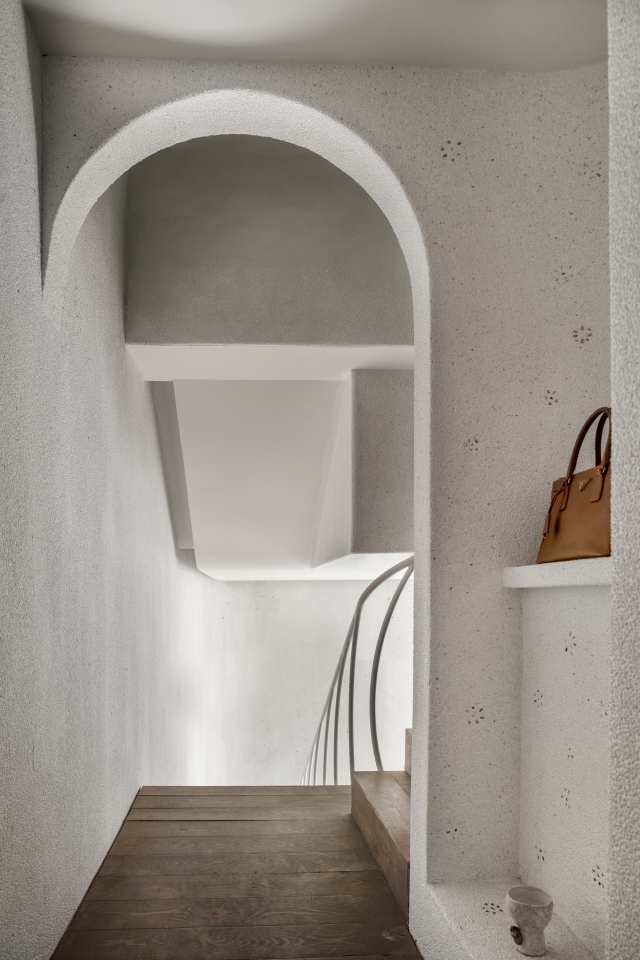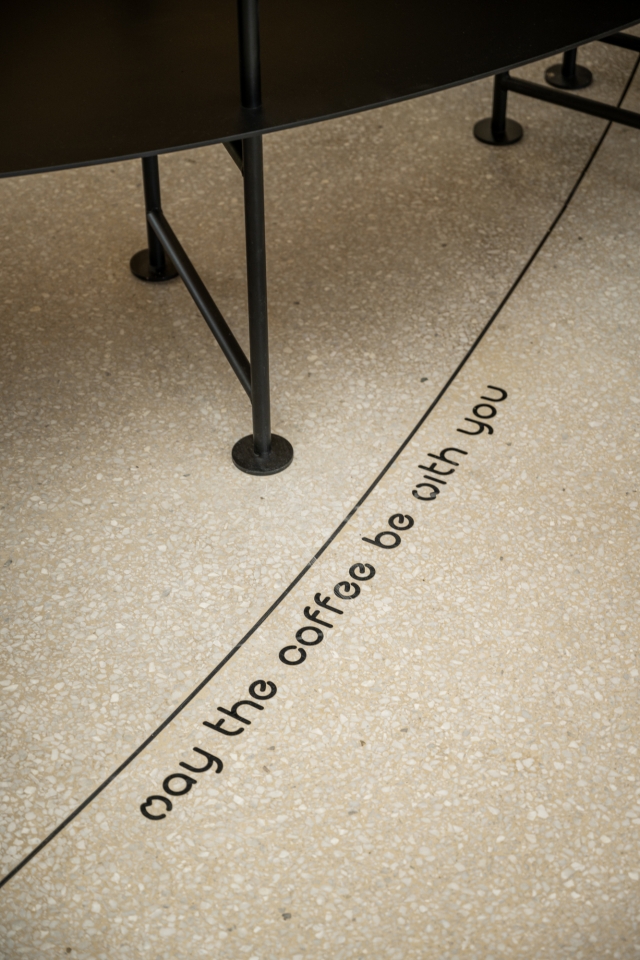Having opened on January 18th, this exhibition delves into the subtle resonance that transcends eras between contemporary portraiture and Pop art. Pop art is often seen as an art of objects. From Jasper Johns’ Beer Cans and Flags to Andy Warhol’s Soup Cans, Brillo Boxes and Coke Bottles; from Roy Lichtenstein’s cartoons and Claes Oldenburg’s soft sculptures to Wayne Thiebaud’s cakes and hotdogs: Pop art is famous for the way in which it sought to portray modern human experience through the endless glut of objects that fills our consumer-oriented world. Yet, while it appeared to venerate the modern consumer object, along with its logos and signs, Pop art was also very much an art of the portrait – one of Pop art’s distinguishing characteristics was its portrayal of people as if they were objects and objects as if they were people.
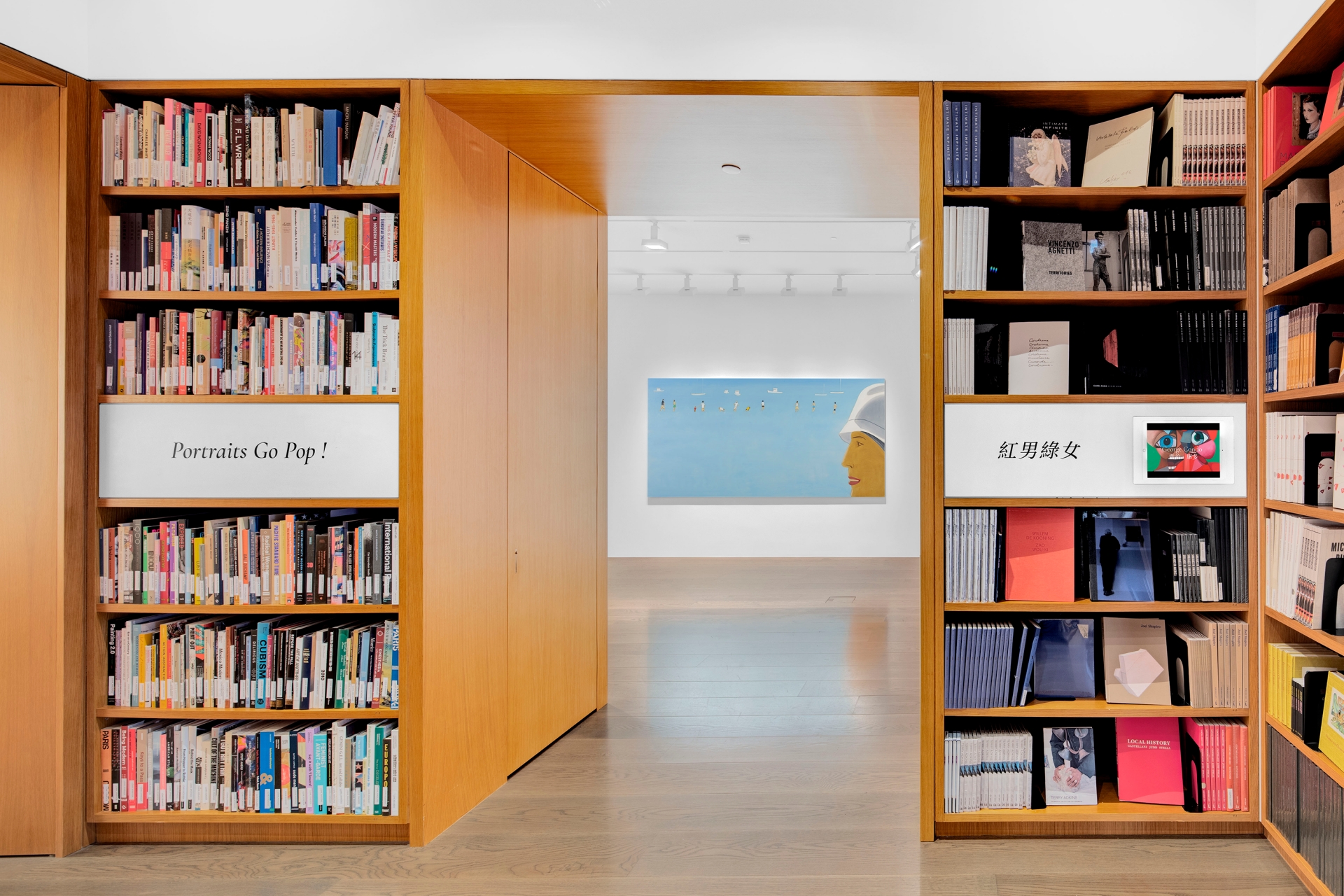
It was essentially Pop art that provided a visual language for individuals to negotiate and explore the complexities of personal, public and private life in a modern, media-dominated, mass-industrial complex. And, as the work of the various artists that have been gathered in this exhibition, Portraits Go Pop, demonstrate, the same remains true today. It is, after all, the very same qualities that Pop art first invested in the portrait that now have once more been taken up by a whole range of 21st century artists as a means of addressing the confusion and anxiety involved in today’s often complicated concepts of selfhood and identity. And once again, it is the same techniques of Pop art portraiture that many of these artists now employ to articulate something of the disappearing borderlines between the virtual and the real and to convey a sense of the increasingly difficult role and function of the individual in a mass-collective culture of perpetual interconnectivity, instant access and image-overload.
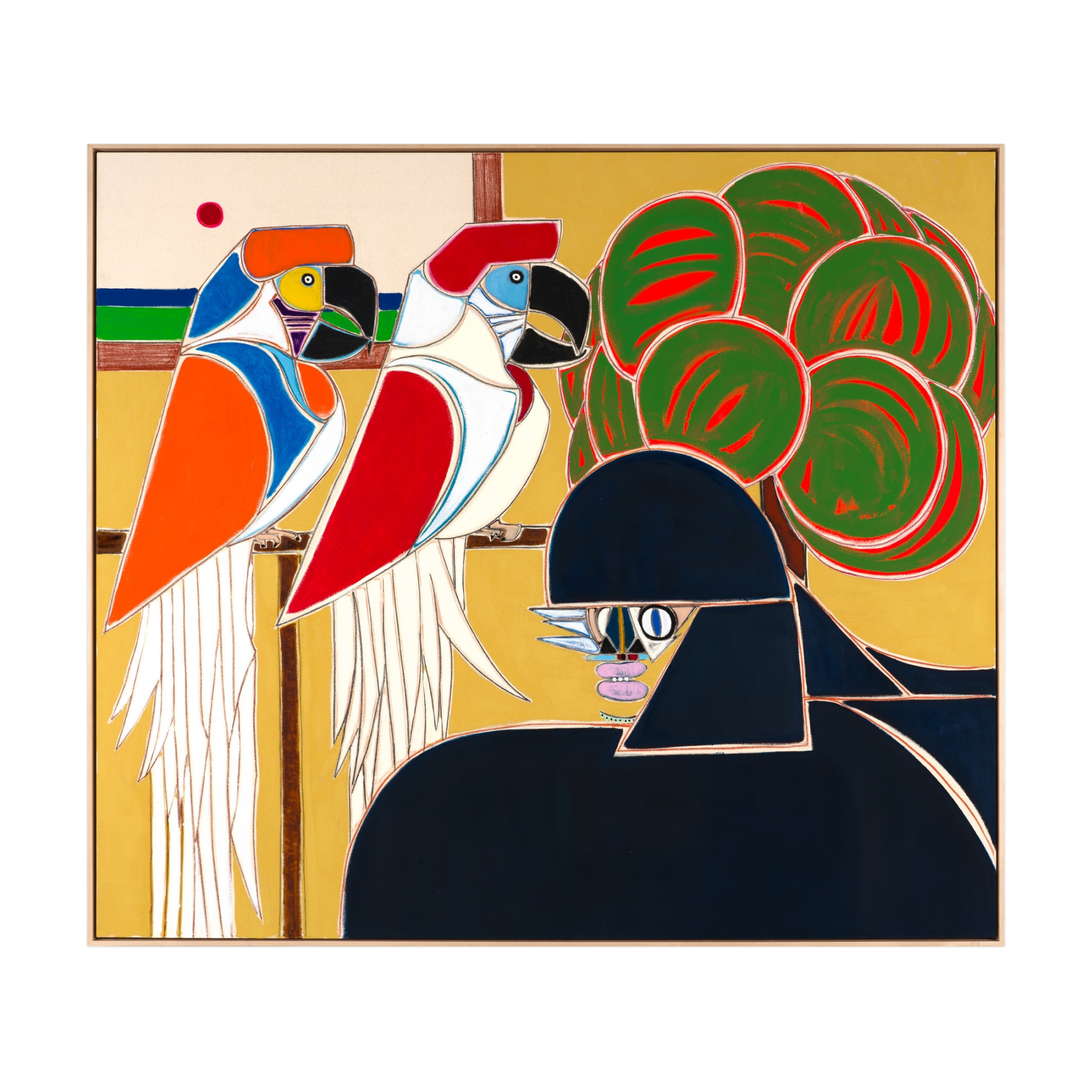
In the Lodge, 2023
Oil paint, Flashe vinyl paint, and pastel pencil on canvas
58 × 66 inches (147.3 × 167.6 cm)
© Susumu Kamijo
Almost all the portraits on show present the “sitters” of their paintings as some sort of artifice, avatar or construct. The great variety of figures on display in these 21st century “Pop” portraits are all essentially approximations or projections of a person, an identity or a character. Although many of these pictures make use of the traditional techniques of oil-on-canvas, these “portraits” are not at all attempts at portraying a person’s inner being, essence or soul, in the traditional manner of Old Master portraiture. Indeed, the whole question of a person’s essence, of a real self, or inner identity appears to be deliberately thrown open to question by these works. The function of the figures in these paintings is, it seems, to serve as masks, avatars or alter-egos; mere vehicles behind which their creators can both hide and either articulate their own feelings or invite the viewer to project theirs onto them. They are, in this respect, proxy portraits or proxy-self-portraits of the kind that first made their appearance in the early 1960s in paintings such as Roy Lichtenstein’s Masterpiece or Mr Bellamy when cartoon figures served the artist, somewhat whimsically, as partial stand-ins for his own more hidden thoughts.
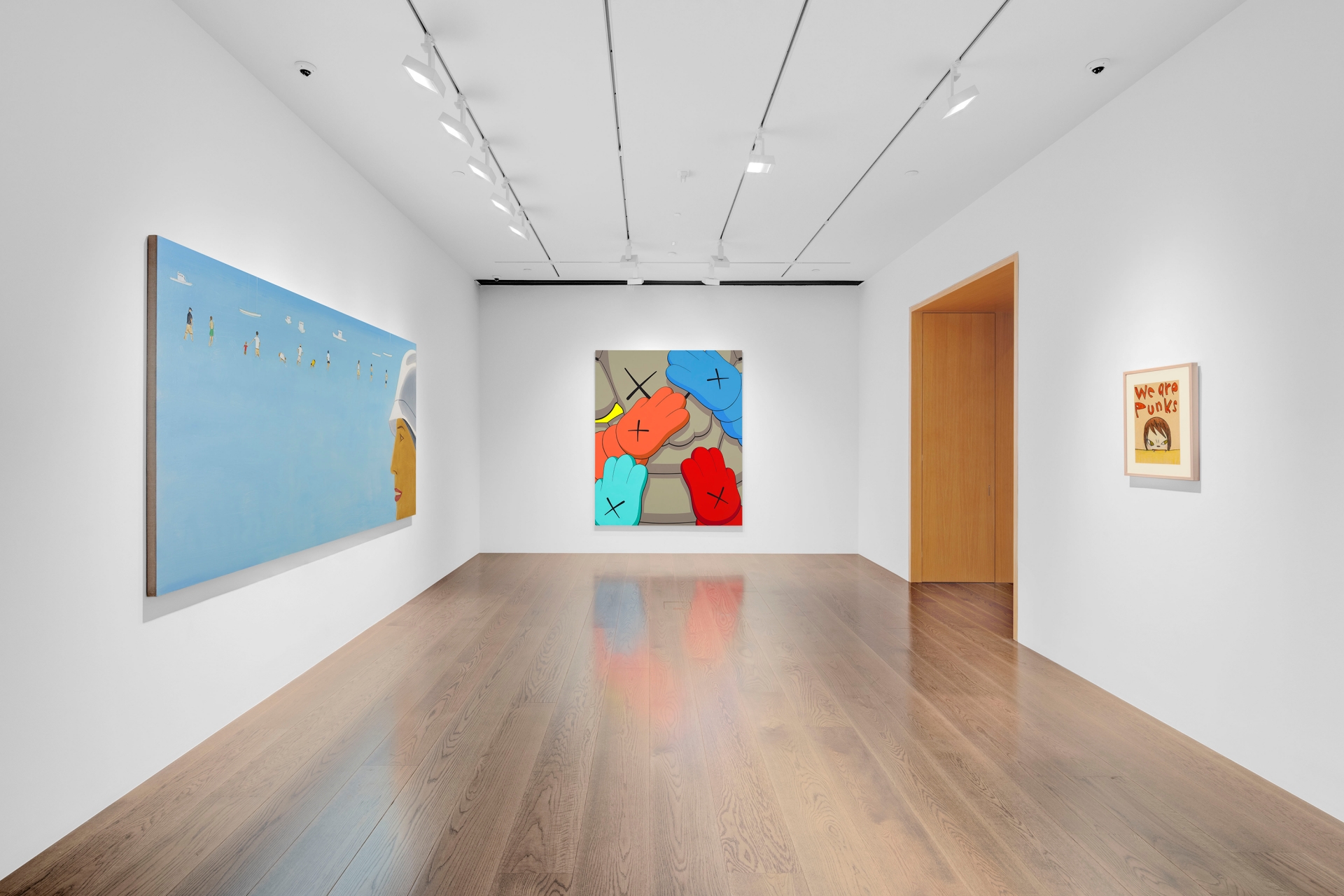
Highlights of the exhibition include two portrait works from George Condo, created in 2018. Condo has coined the terms “Artificial Realism” and “Psychological Cubism” to describe his portraits of impossible figures that, making use of a variety of techniques drawn from all areas of art history, appear to portray the individual as a complex and often beguiling construction of multiple identities, moods, facial tics and grimaces. In Untitled and Untitled Head of 2018, it is both a sense of the personality as an artificial construct and of the multiple characters and moods contained within collective society that his extraordinary figures present. Condo’s bizarre objects inhabit an ambiguous, unreal, and uncertain space, which, like that of much “Pop” art, appears to lie halfway between the representational and the conceptual. The figures in Condo’s works are deliberately disorientating and reinforce this anxious sense of floundering in a landscape of ambiguity.
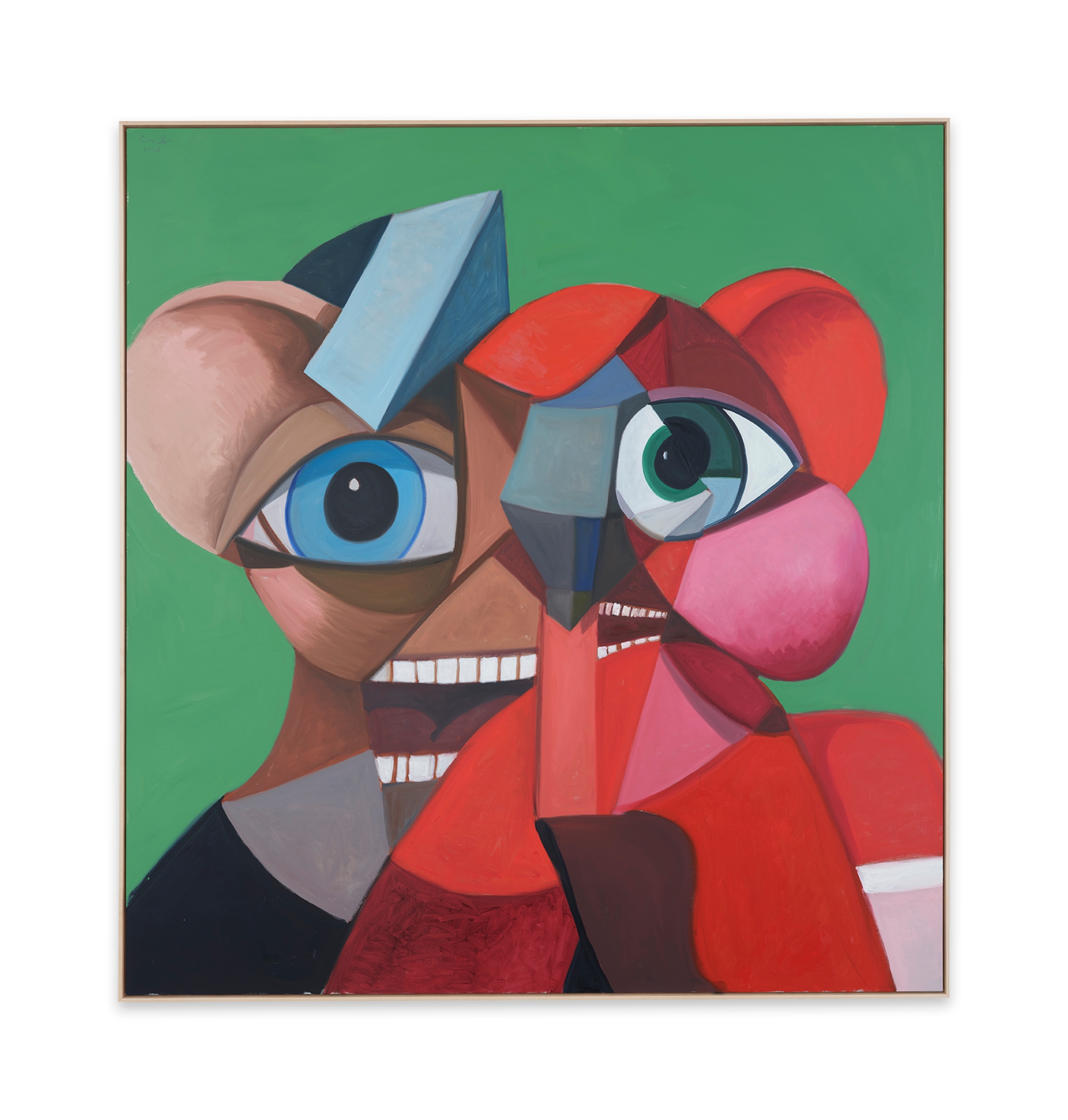
Untitled Head, 2018
Oil on canvas
84 × 80 inches (213.4 × 203.2 cm)
© George Condo
Such deliberate disorientation and the embracing of ambiguity is also a characteristic that underpins the very different approaches to portraiture taken by artists such as Yoshimoto Nara and Liu Ye. Though very different in many respects, all of the personae that inhabit the work of these three painters exist in similarly mysterious and deliberately uncertain realms. Liu Ye’s familiar-looking figures, are ones that exude an almost Balthus-like sense of mystery and enigma. Reflecting Liu’s love of cinema and storytelling, his pictures are painstakingly crafted combinations of the real and the imaginary that generate a fusion of Eastern and Western culture, cartoon figures, cinematic imaginings and 1920s realist style painting. Xiao Fang – one of his celebrated, imaginary, bare-breasted little girls shown holding piglets – are also deliberately provocative fictions. They are figures that appear to hover between states of vulnerability and power, youth and adulthood, innocence and experience. Infused with a warm ret- ro-cinema feel and with memories of both the propaganda imagery Liu witnessed as a youth growing up in China and a sense of the comforting banality of the cartoon characters he encountered while studying in Europe, Liu’s personae inhabit and define a strange netherworld that is replete with suggestive, but ultimately indecipherable symbols. “There’s a tension in my paintings between the desire to be abstract and the need to borrow from the concrete to convey meaning,” Liu has explained. “Red could symbolise revolution, joy, violence or bloodiness. A single answer is therefore one-dimensional and inaccurate. I try not to provide single answers in my paintings. In fact, I don’t have that power. My solution is to provide space for interpretation.”
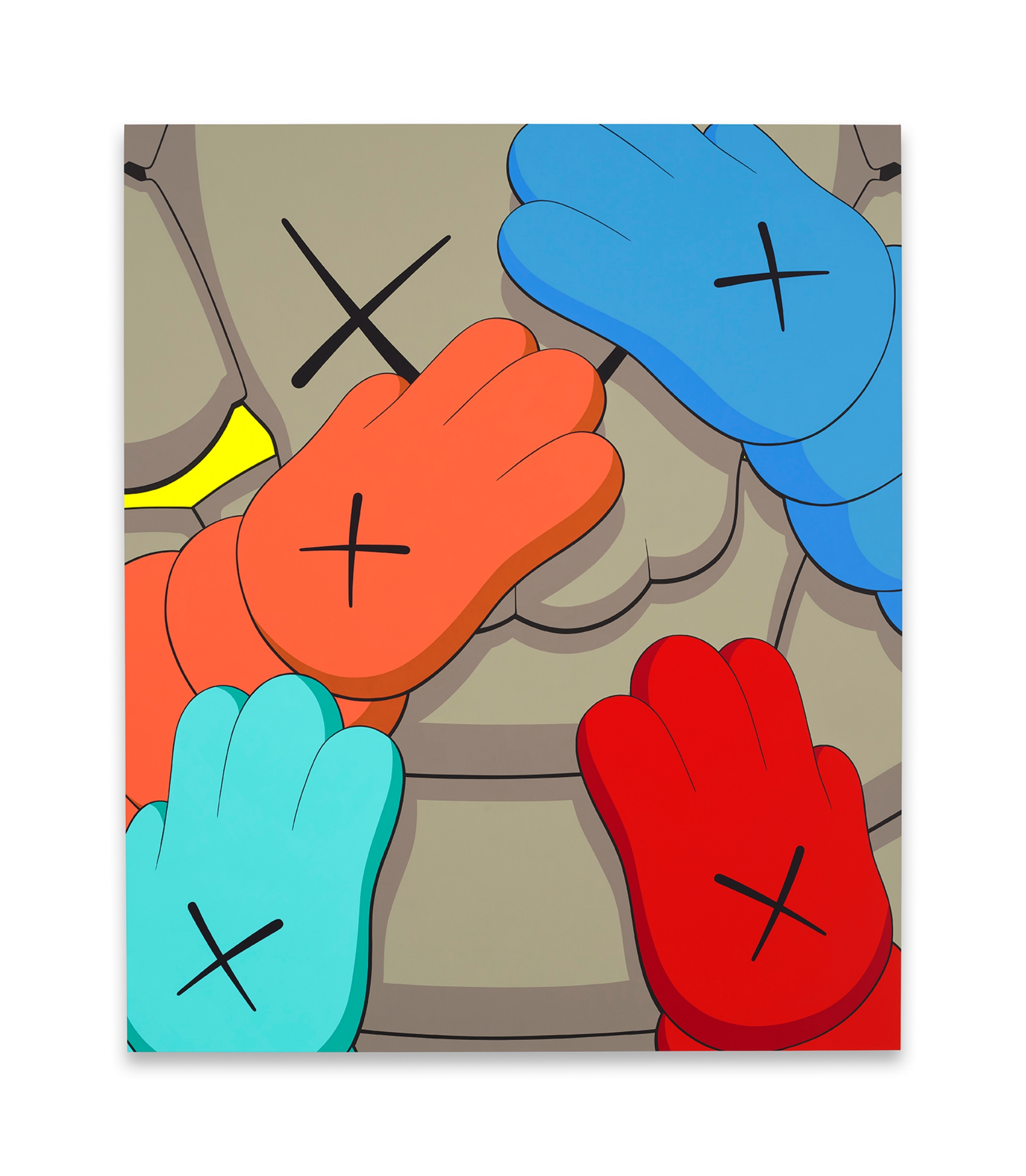
URGE (KUB8), 2020
Acrylic on canvas
86 × 72 inches (218.4 × 182.9 cm)
© KAWS
Yoshimoto Nara’s much-loved pantheon of “Pop” characters exist in a similarly open and ambiguous space, but in his case the often-deceptive sweetness of his figures serves as a vehicle intended to invite the viewer to recognise in them their own frustrations and emotions. His famous, sweet-faced, but often evil, little girl, “Little Ramona” (named after Nara’s favourite punk band the Ramones), seen here in vampiric form in his 2011 painting We are Punks, has even been championed as a kind of avatar for the millennial generation. She has become what one critic has described as a “symbolic representation of the dominant feelings of Japanese youth in the late 1990s and early 2000s, characterised by a sense of uncertainty about the future, vulnerability, and a yearning for the innocence preserved in the inner child.” Nara’s work is often thought to emulate the imaginary worlds of animé or manga, but this is not the case. Rather than embrace this imagery, like Takashi Murakami or an artist like Mr., for example, who has, he says, found an escape from the burdens of reality in such a practice, Nara has always drawn on more “retro” sources of inspiration. “I don't dislike manga,’ Nara has explained, ‘but I'm not interested in it, and I don't watch anime ́ at all.”
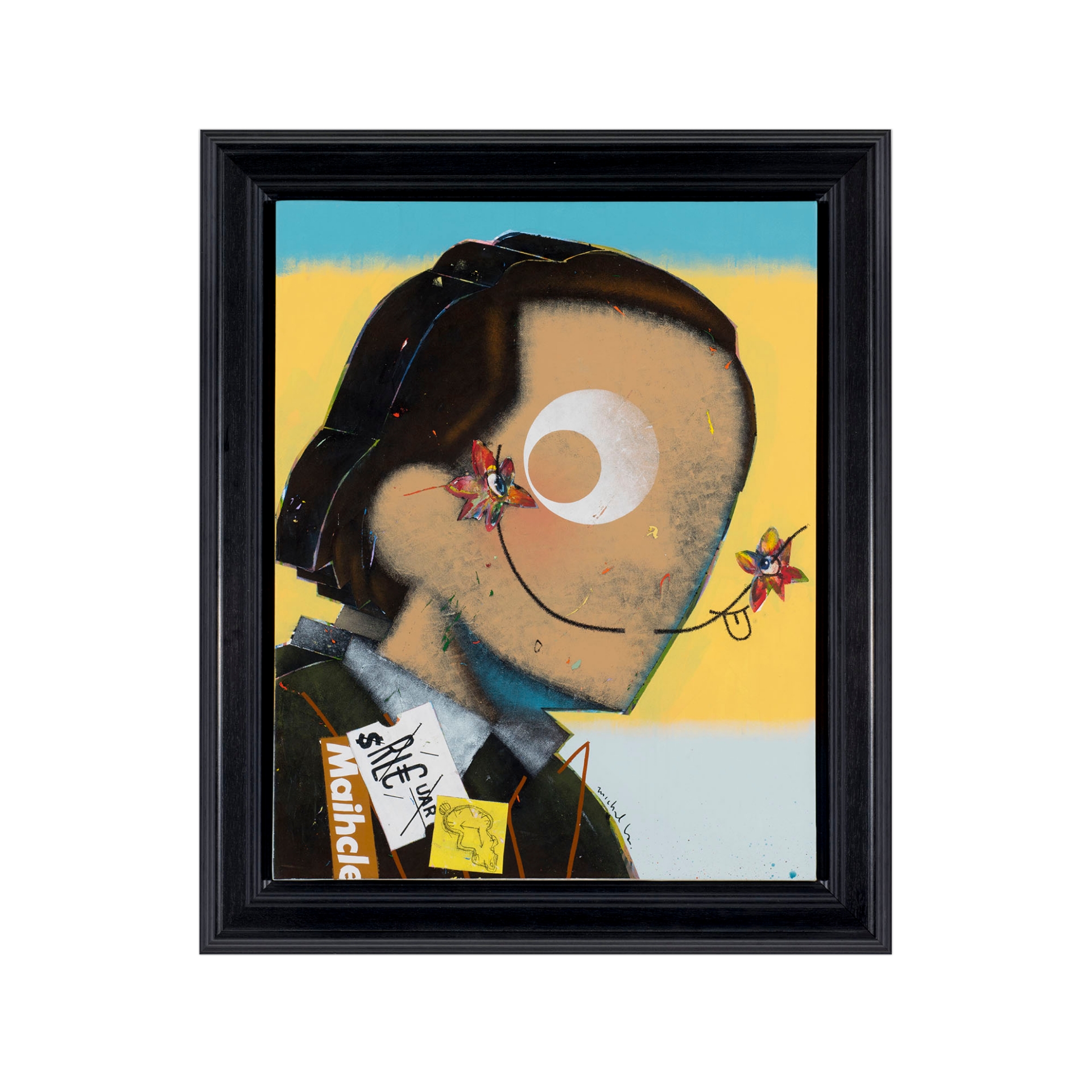
Portrait Series: Michael Surreal, 2022 Acrylic on canvas
29 15/16 × 24 inches (76 × 61 cm)
© Michael Lau
In direct contrast, the art of KAWS is wholly immersed in the “virtual” universe of cartoon reality. It can also, in many ways, be seen as a literal representation of the “cross-over” of culture and the world of consumerist mass-media. Like the implicit vacancy in Andy Warhol’s flat, mechanically-produced silk- screen canvases and the shiny surfaces of Jeff Koons’ luxuriant, but ultimately hollow creations, KAWS’ trademark skull-and-crossbones head with its crossed-out eyes, as in URGE (KUB8) (2020), is also an icon of emptiness. Like the enigma inherent to Liu and Nara’s figures, the deliberate banality of KAWS’ work is such that it too asserts its own, new, conceptual reality. Like a glitch in the system, KAWS’ creations inhabit a netherworld space that exists, disturbingly easily, part-way between the realms of traditional art, pop culture, kitsch and commerce. “Icons like Mickey, the Simpsons, the Michelin Man and SpongeBob”, Brian Donnelly (KAWS) has said, “exist in a universal way that you forget their origin or even their narrative, and you just recognize them from the slightest glimpse of their image or sound.”
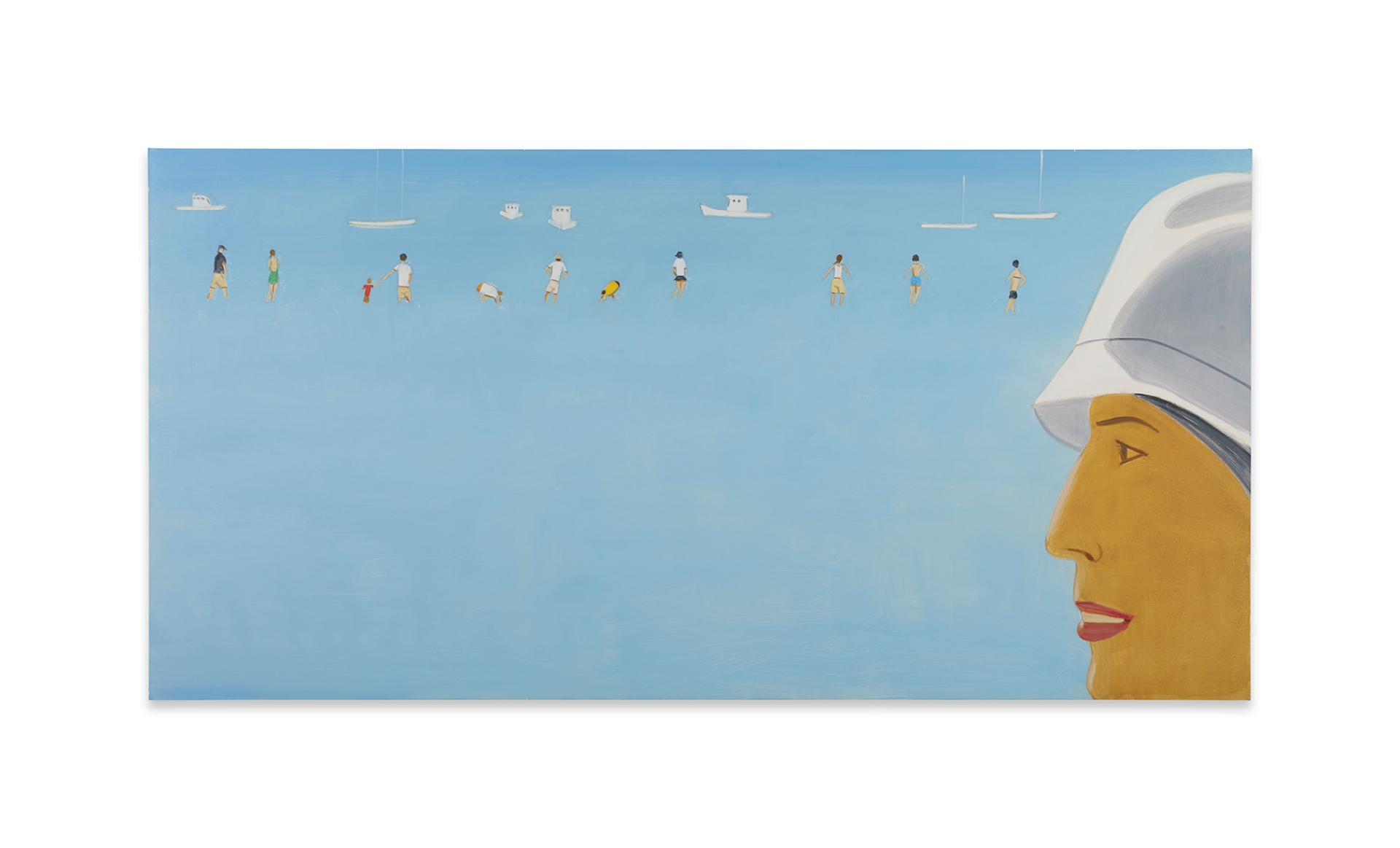
Untitled (Beach Scene), 2012–13
Oil on linen
60 1/16 × 120 1/16 inches (152.5 × 305 cm)
© Alex Katz
Where KAWS appears to manifest only emptiness in the slick, flatness of surface, however, Alex Katz finds mystery and depth. Originally influenced by billboard art and their advertisements’ imposing use of bold swaths of colour, Katz, now in his nineties, has turned this language into a traditional form of painting. Despite belonging to the original 1960s Pop generation, Katz is not a Pop artist. Nor is he really an artist who paints “Pop” portraits. “Pop art deals with signs”, Katz has said, “while my work deals with symbols. Pop art is modern. My work is traditional.” Where the near-billboard size Untitled (Beach Scene) (2012–13) relates to the other portraits in this exhibition, however, is in the way that Katz manages to bestow his subjects with a strange pictorial sense of reality/unreality similar to that of much pop portraiture. Like Katz’s veneration of tradition and Condo’s approximation of Old Master technique, Mickalene Thomas is also an artist who is happily and knowingly "retro" in her approach. Her celebrated Tête de Femme series not only deliberately reclaims its title from Picasso, but also makes use of large-scale mixed-media to assert a series of powerful and imposing black, female presences all articulated in the pictorial language of Cubism. Deriving from a collaboration with the make-up artist Vincent Oquen- do, with whom Thomas began making small collages that engaged Oquendo’s intuitive appreciation of facial angles and colourful application of make-up, these portraits are reinventions on a giant scale of both Dadaist photomontage and of an artist like Eduardo Paolozzi’s proto-pop collage portraits from the late-1940s. Combining rhinestones, glitter and crystal fabric into the fragmentary logic of their construction, these demonstrably artificial visages are all imbued with both a modern sense of the glamour of the modern fashion world and with the feisty edginess and DIY attitude of 1970s Punk.
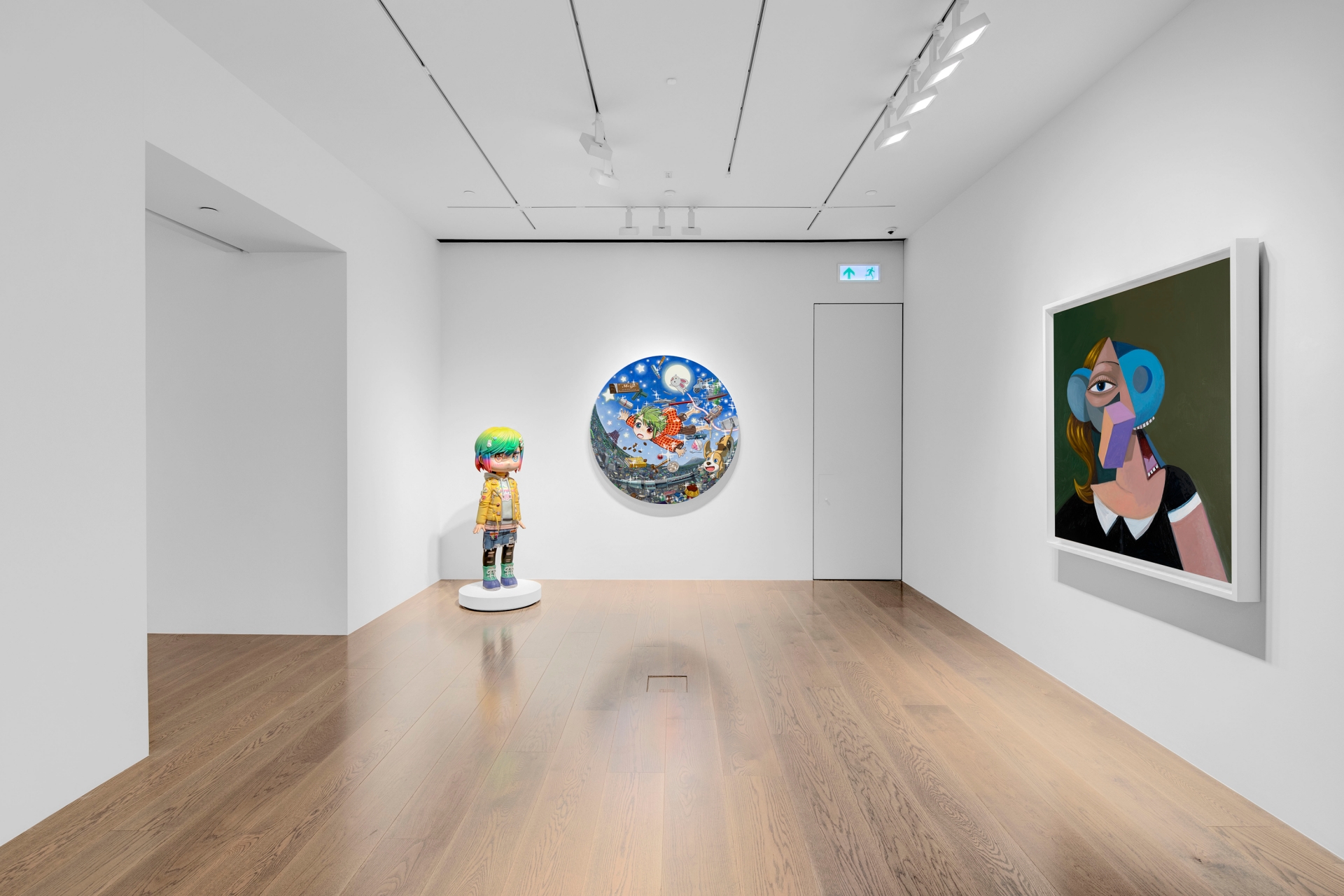
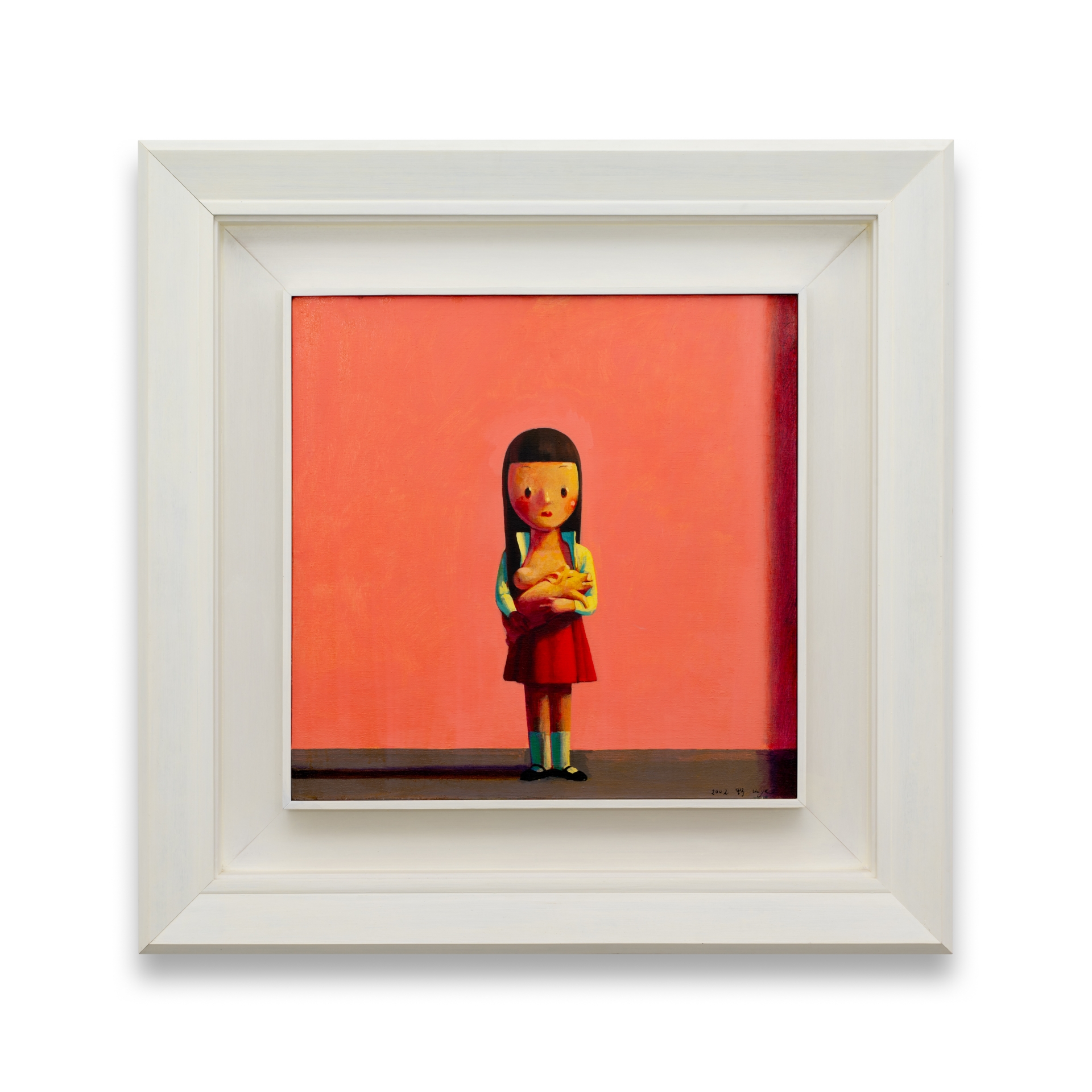
Xiao Fang and Piggy, 2002
Acrylic on canvas 235/8×235/8inches(60×60cm)
© Liu Ye
The exhibition also features "In the Lodge" (2023) by New York-based Japanese artist Susumu Kamijo. Drawing inspiration from a wide range of sources that include German Expressionism, Willem de Kooning, and the distortive logic of Francis Bacon’s portraiture, Kamijo depicts a strange world of animals and human faces using bold, simplistic, outlines and abstract blocks of colour. In this way Kamijo is skilfully able to construct a unique and playful sequence of portrait-like compositions that transform the ordinary and the everyday into the exotic and invoke deep emotion.
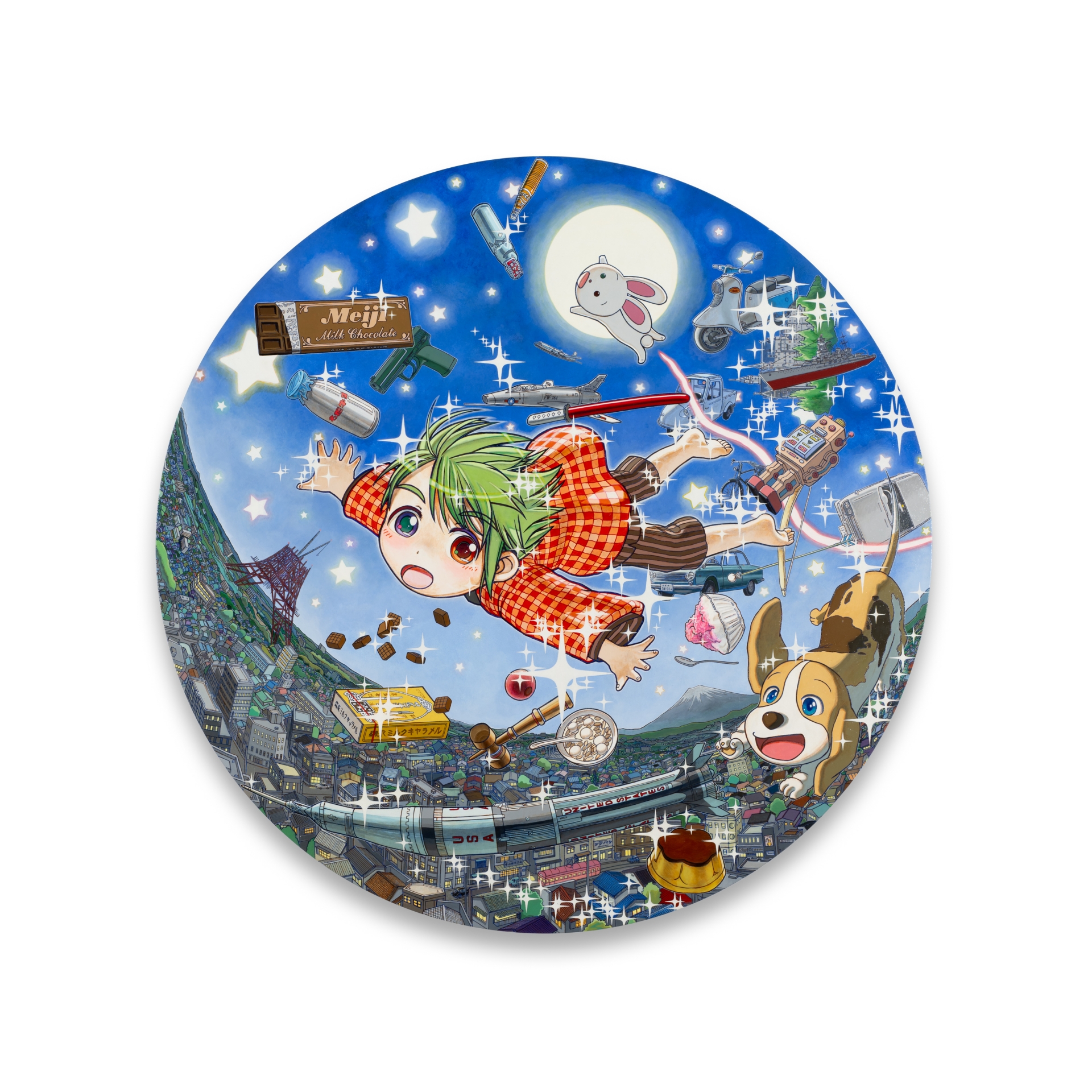
Acrylic on canvas
Diam: 59 1/16 inches (150 cm)
© Mr.
"Portrait Series: Michael Surreal" (2022) by Hong Kong contemporary artist Michael Lau is also a work that departs from the traditional techniques of portraiture while drawing upon a famous art historical precedent. "Portrait Series: Michael Surreal" is a semi-abstract graffiti-like fusion of his own self- image with the ‘Pop’ accoutrements of Surrealism’s most iconic ambassador, Salvador Dali, in the form of Dali’s moustache, his soft-watch and associative price tag. Deliberately eschewing the depiction of any intricate facial features in favour of abstraction, Lau prefers to portray the question of the identity of his subject solely through a play of associative objects and symbols. Known as the ‘Godfather’ of the Designer and Art toy movement, Lau here, therefore has created a portrait in which not only are the boundaries between abstraction and representation and between the art and the object cleverly blurred but also, once again, those between image and identity.
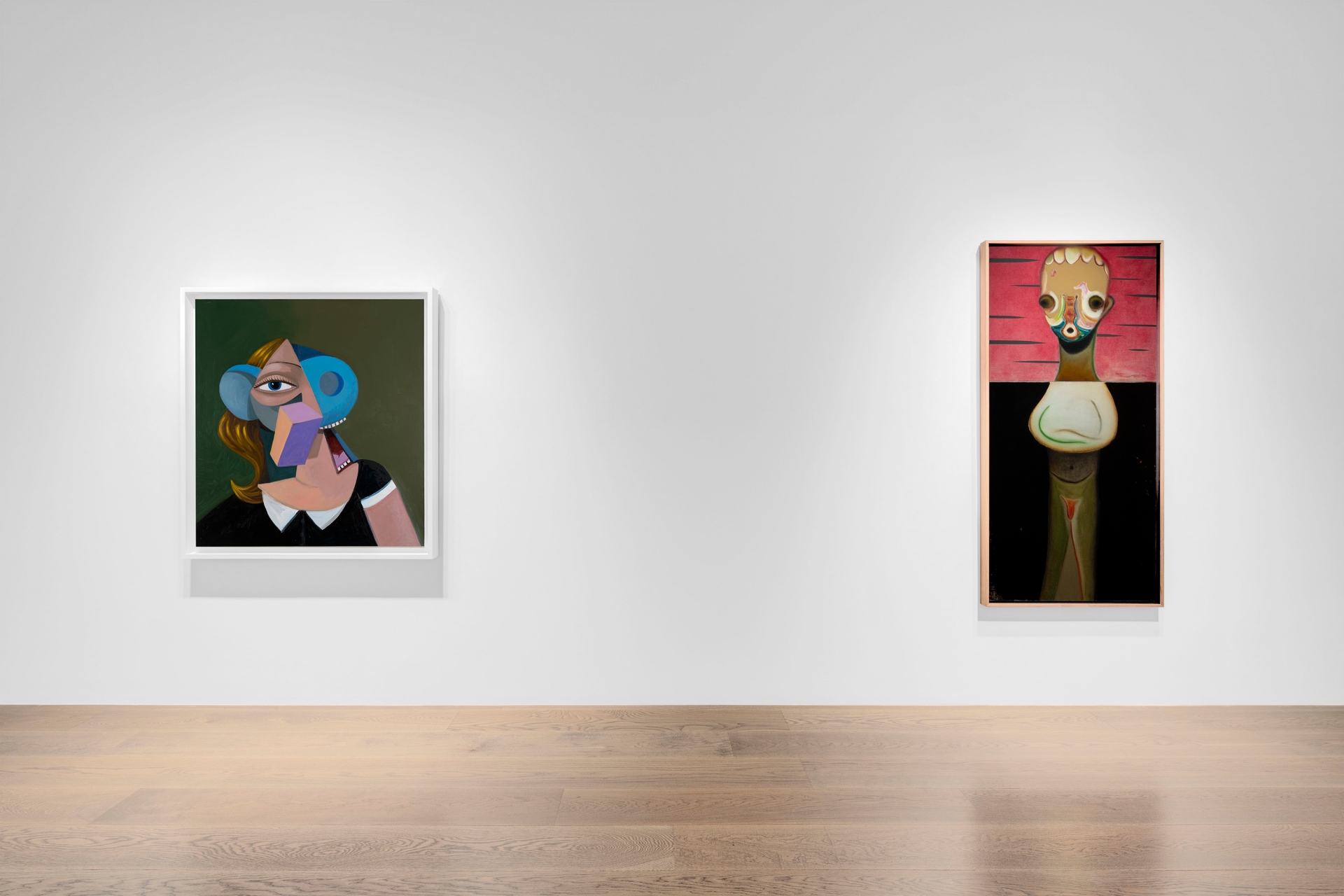

We Are Punks, 2011
Color pencil on paper
16 9/16 × 11 3/4 inches (42 × 29.8 cm)
© Yoshitomo Nara






